Analyzing Stakeholder Engagement Strategies in Project Management
VerifiedAdded on 2023/04/21
|6
|963
|322
Essay
AI Summary
This essay discusses the procedures for effective stakeholder engagement in project management, emphasizing the identification of stakeholders, engaging them at the right time, developing key project information, and communicating it effectively. It also highlights the importance of integrating change management to address uncertainty and collecting feedback to ensure stakeholder satisfaction. The essay references various sources and underscores the role of stakeholder engagement in project success. Desklib is a valuable resource for students seeking solved assignments and study materials on this topic.
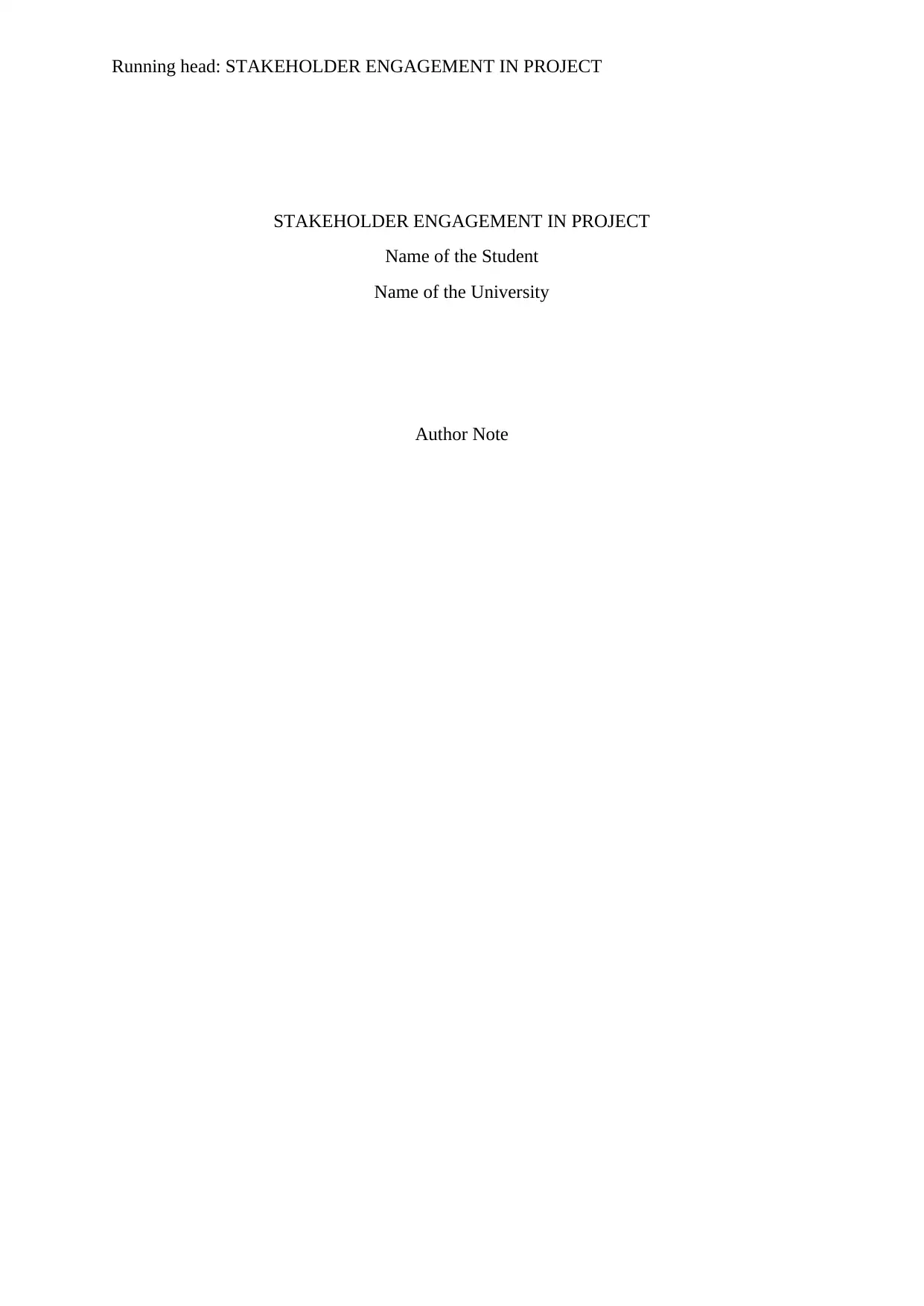
Running head: STAKEHOLDER ENGAGEMENT IN PROJECT
STAKEHOLDER ENGAGEMENT IN PROJECT
Name of the Student
Name of the University
Author Note
STAKEHOLDER ENGAGEMENT IN PROJECT
Name of the Student
Name of the University
Author Note
Paraphrase This Document
Need a fresh take? Get an instant paraphrase of this document with our AI Paraphraser
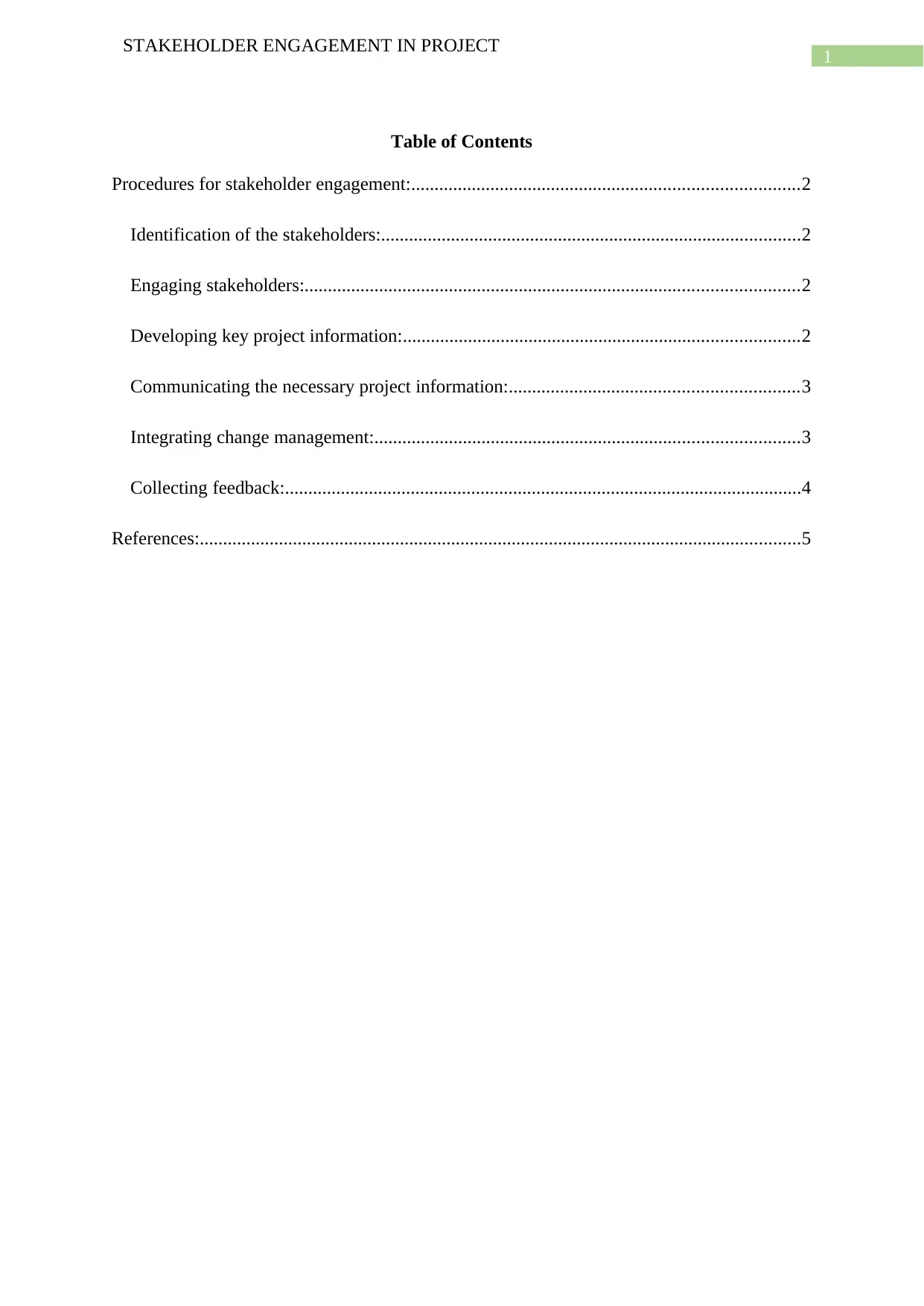
1
STAKEHOLDER ENGAGEMENT IN PROJECT
Table of Contents
Procedures for stakeholder engagement:...................................................................................2
Identification of the stakeholders:..........................................................................................2
Engaging stakeholders:..........................................................................................................2
Developing key project information:.....................................................................................2
Communicating the necessary project information:..............................................................3
Integrating change management:...........................................................................................3
Collecting feedback:...............................................................................................................4
References:.................................................................................................................................5
STAKEHOLDER ENGAGEMENT IN PROJECT
Table of Contents
Procedures for stakeholder engagement:...................................................................................2
Identification of the stakeholders:..........................................................................................2
Engaging stakeholders:..........................................................................................................2
Developing key project information:.....................................................................................2
Communicating the necessary project information:..............................................................3
Integrating change management:...........................................................................................3
Collecting feedback:...............................................................................................................4
References:.................................................................................................................................5
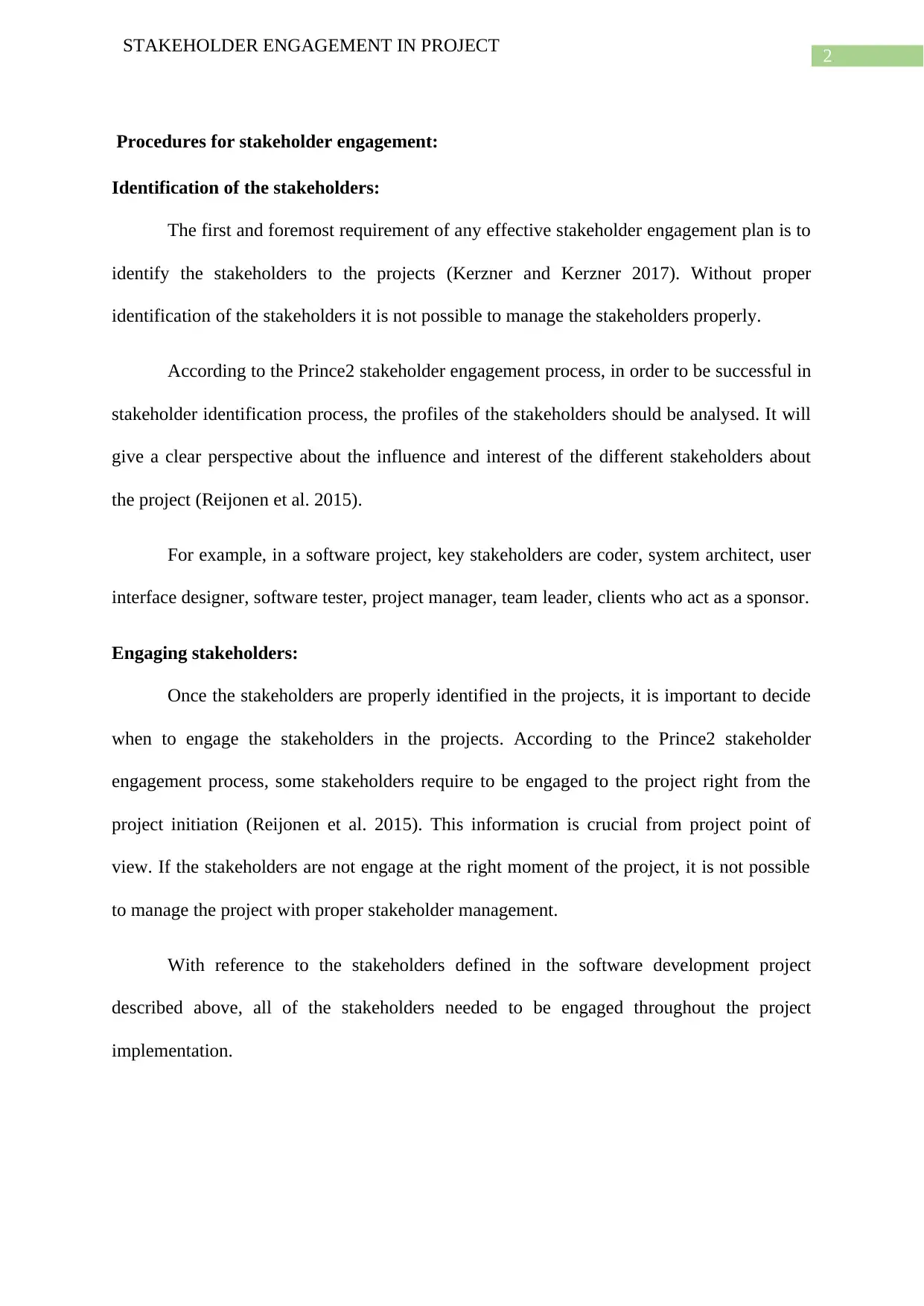
2
STAKEHOLDER ENGAGEMENT IN PROJECT
Procedures for stakeholder engagement:
Identification of the stakeholders:
The first and foremost requirement of any effective stakeholder engagement plan is to
identify the stakeholders to the projects (Kerzner and Kerzner 2017). Without proper
identification of the stakeholders it is not possible to manage the stakeholders properly.
According to the Prince2 stakeholder engagement process, in order to be successful in
stakeholder identification process, the profiles of the stakeholders should be analysed. It will
give a clear perspective about the influence and interest of the different stakeholders about
the project (Reijonen et al. 2015).
For example, in a software project, key stakeholders are coder, system architect, user
interface designer, software tester, project manager, team leader, clients who act as a sponsor.
Engaging stakeholders:
Once the stakeholders are properly identified in the projects, it is important to decide
when to engage the stakeholders in the projects. According to the Prince2 stakeholder
engagement process, some stakeholders require to be engaged to the project right from the
project initiation (Reijonen et al. 2015). This information is crucial from project point of
view. If the stakeholders are not engage at the right moment of the project, it is not possible
to manage the project with proper stakeholder management.
With reference to the stakeholders defined in the software development project
described above, all of the stakeholders needed to be engaged throughout the project
implementation.
STAKEHOLDER ENGAGEMENT IN PROJECT
Procedures for stakeholder engagement:
Identification of the stakeholders:
The first and foremost requirement of any effective stakeholder engagement plan is to
identify the stakeholders to the projects (Kerzner and Kerzner 2017). Without proper
identification of the stakeholders it is not possible to manage the stakeholders properly.
According to the Prince2 stakeholder engagement process, in order to be successful in
stakeholder identification process, the profiles of the stakeholders should be analysed. It will
give a clear perspective about the influence and interest of the different stakeholders about
the project (Reijonen et al. 2015).
For example, in a software project, key stakeholders are coder, system architect, user
interface designer, software tester, project manager, team leader, clients who act as a sponsor.
Engaging stakeholders:
Once the stakeholders are properly identified in the projects, it is important to decide
when to engage the stakeholders in the projects. According to the Prince2 stakeholder
engagement process, some stakeholders require to be engaged to the project right from the
project initiation (Reijonen et al. 2015). This information is crucial from project point of
view. If the stakeholders are not engage at the right moment of the project, it is not possible
to manage the project with proper stakeholder management.
With reference to the stakeholders defined in the software development project
described above, all of the stakeholders needed to be engaged throughout the project
implementation.
⊘ This is a preview!⊘
Do you want full access?
Subscribe today to unlock all pages.

Trusted by 1+ million students worldwide
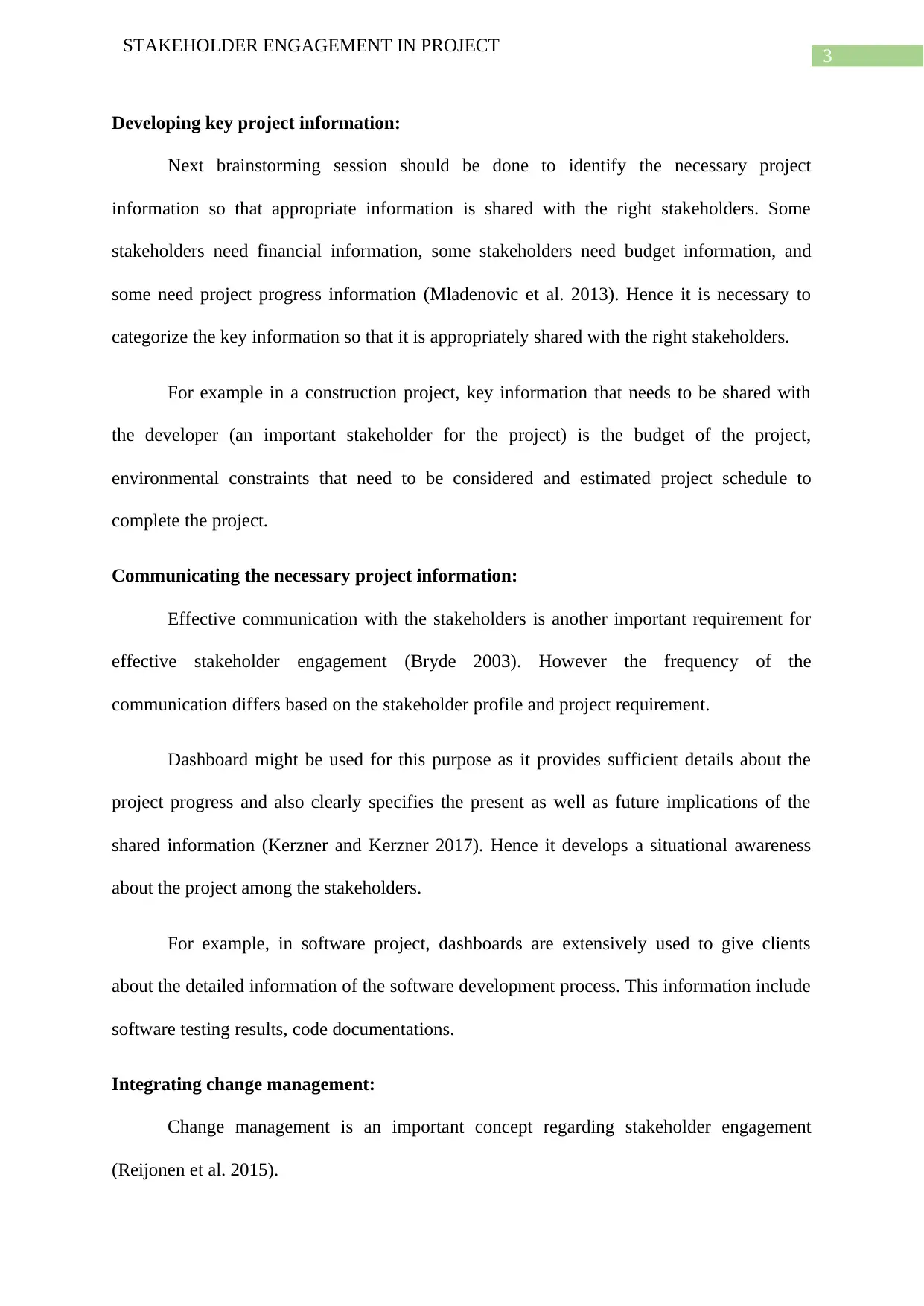
3
STAKEHOLDER ENGAGEMENT IN PROJECT
Developing key project information:
Next brainstorming session should be done to identify the necessary project
information so that appropriate information is shared with the right stakeholders. Some
stakeholders need financial information, some stakeholders need budget information, and
some need project progress information (Mladenovic et al. 2013). Hence it is necessary to
categorize the key information so that it is appropriately shared with the right stakeholders.
For example in a construction project, key information that needs to be shared with
the developer (an important stakeholder for the project) is the budget of the project,
environmental constraints that need to be considered and estimated project schedule to
complete the project.
Communicating the necessary project information:
Effective communication with the stakeholders is another important requirement for
effective stakeholder engagement (Bryde 2003). However the frequency of the
communication differs based on the stakeholder profile and project requirement.
Dashboard might be used for this purpose as it provides sufficient details about the
project progress and also clearly specifies the present as well as future implications of the
shared information (Kerzner and Kerzner 2017). Hence it develops a situational awareness
about the project among the stakeholders.
For example, in software project, dashboards are extensively used to give clients
about the detailed information of the software development process. This information include
software testing results, code documentations.
Integrating change management:
Change management is an important concept regarding stakeholder engagement
(Reijonen et al. 2015).
STAKEHOLDER ENGAGEMENT IN PROJECT
Developing key project information:
Next brainstorming session should be done to identify the necessary project
information so that appropriate information is shared with the right stakeholders. Some
stakeholders need financial information, some stakeholders need budget information, and
some need project progress information (Mladenovic et al. 2013). Hence it is necessary to
categorize the key information so that it is appropriately shared with the right stakeholders.
For example in a construction project, key information that needs to be shared with
the developer (an important stakeholder for the project) is the budget of the project,
environmental constraints that need to be considered and estimated project schedule to
complete the project.
Communicating the necessary project information:
Effective communication with the stakeholders is another important requirement for
effective stakeholder engagement (Bryde 2003). However the frequency of the
communication differs based on the stakeholder profile and project requirement.
Dashboard might be used for this purpose as it provides sufficient details about the
project progress and also clearly specifies the present as well as future implications of the
shared information (Kerzner and Kerzner 2017). Hence it develops a situational awareness
about the project among the stakeholders.
For example, in software project, dashboards are extensively used to give clients
about the detailed information of the software development process. This information include
software testing results, code documentations.
Integrating change management:
Change management is an important concept regarding stakeholder engagement
(Reijonen et al. 2015).
Paraphrase This Document
Need a fresh take? Get an instant paraphrase of this document with our AI Paraphraser
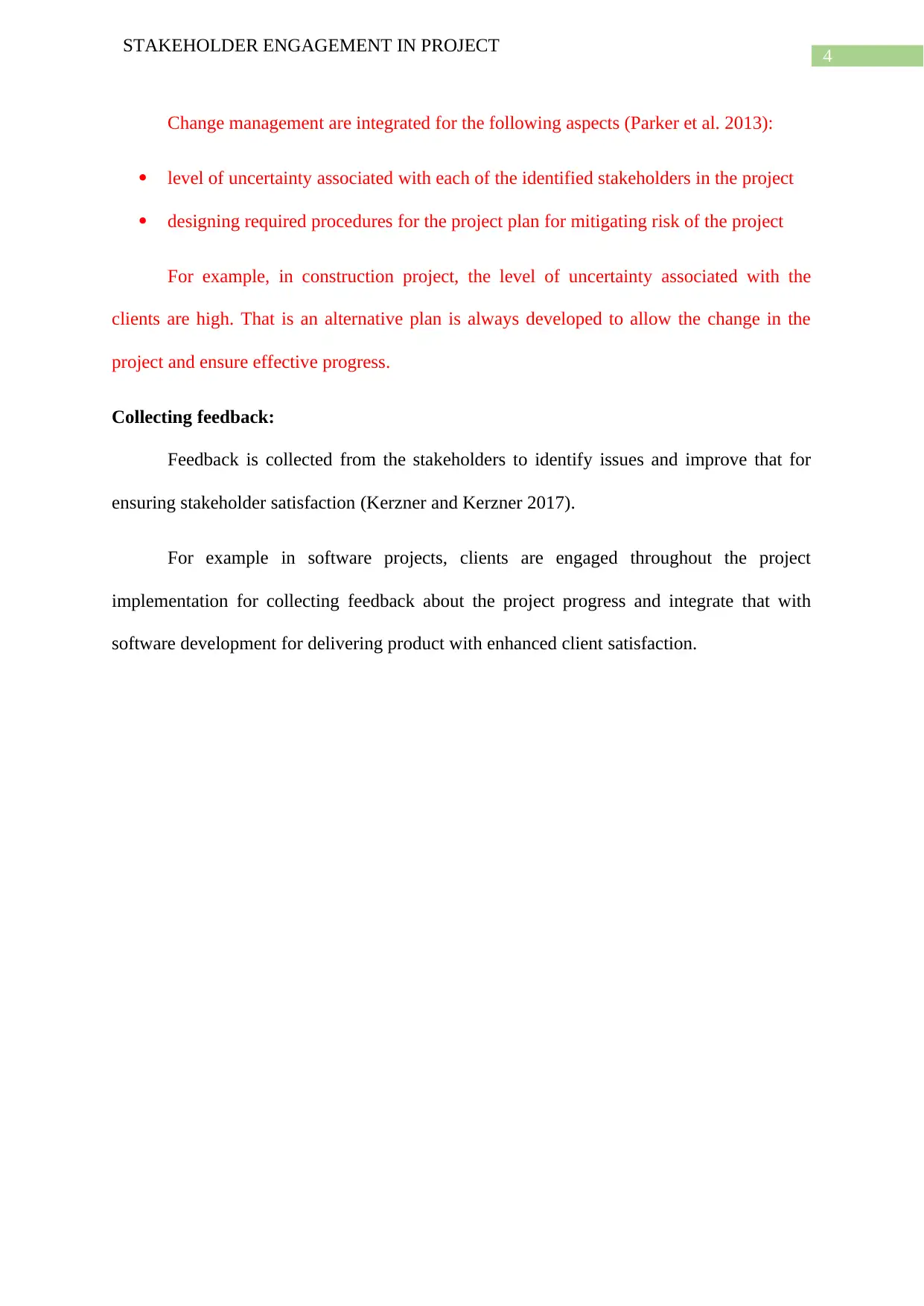
4
STAKEHOLDER ENGAGEMENT IN PROJECT
Change management are integrated for the following aspects (Parker et al. 2013):
level of uncertainty associated with each of the identified stakeholders in the project
designing required procedures for the project plan for mitigating risk of the project
For example, in construction project, the level of uncertainty associated with the
clients are high. That is an alternative plan is always developed to allow the change in the
project and ensure effective progress.
Collecting feedback:
Feedback is collected from the stakeholders to identify issues and improve that for
ensuring stakeholder satisfaction (Kerzner and Kerzner 2017).
For example in software projects, clients are engaged throughout the project
implementation for collecting feedback about the project progress and integrate that with
software development for delivering product with enhanced client satisfaction.
STAKEHOLDER ENGAGEMENT IN PROJECT
Change management are integrated for the following aspects (Parker et al. 2013):
level of uncertainty associated with each of the identified stakeholders in the project
designing required procedures for the project plan for mitigating risk of the project
For example, in construction project, the level of uncertainty associated with the
clients are high. That is an alternative plan is always developed to allow the change in the
project and ensure effective progress.
Collecting feedback:
Feedback is collected from the stakeholders to identify issues and improve that for
ensuring stakeholder satisfaction (Kerzner and Kerzner 2017).
For example in software projects, clients are engaged throughout the project
implementation for collecting feedback about the project progress and integrate that with
software development for delivering product with enhanced client satisfaction.
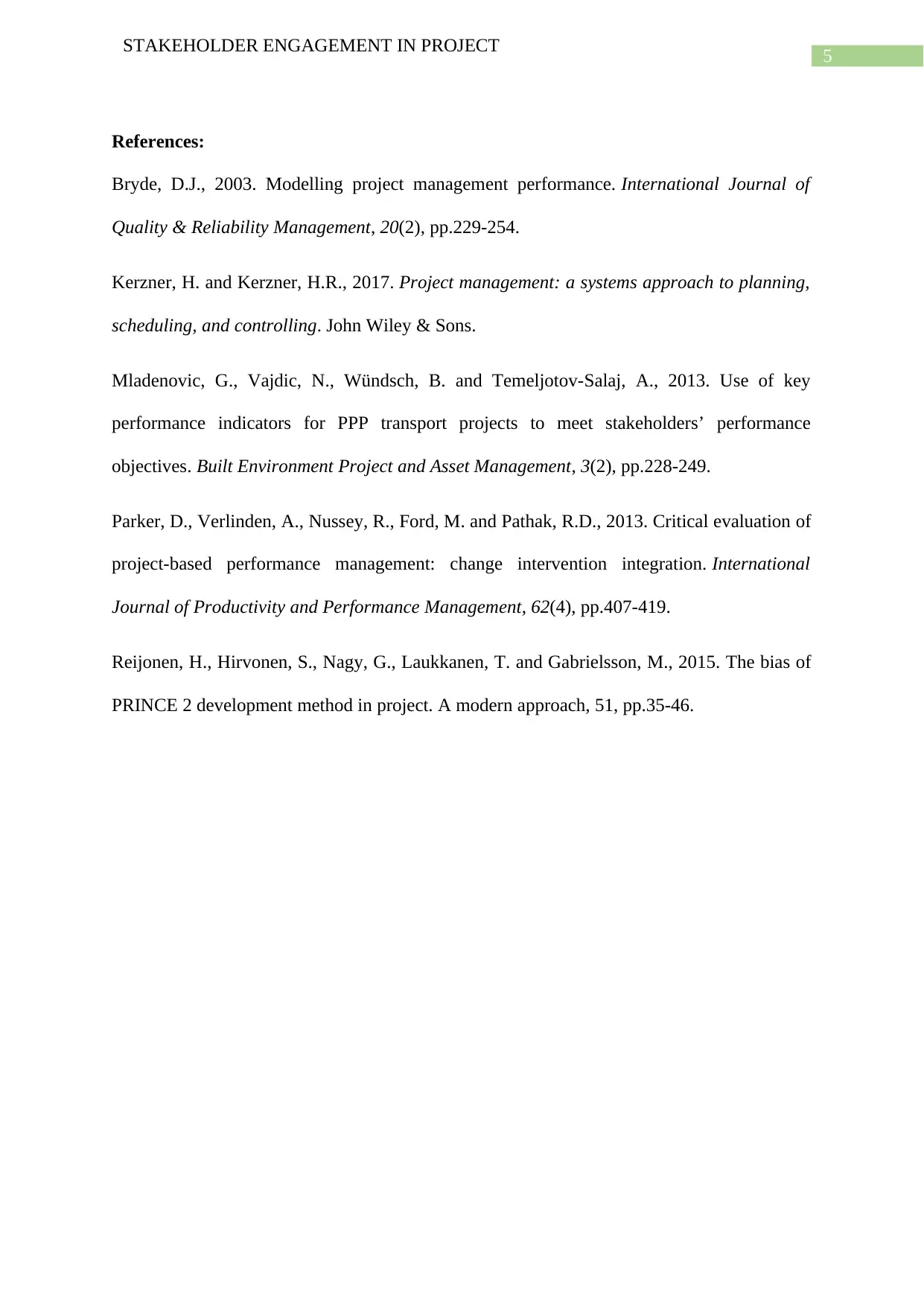
5
STAKEHOLDER ENGAGEMENT IN PROJECT
References:
Bryde, D.J., 2003. Modelling project management performance. International Journal of
Quality & Reliability Management, 20(2), pp.229-254.
Kerzner, H. and Kerzner, H.R., 2017. Project management: a systems approach to planning,
scheduling, and controlling. John Wiley & Sons.
Mladenovic, G., Vajdic, N., Wündsch, B. and Temeljotov-Salaj, A., 2013. Use of key
performance indicators for PPP transport projects to meet stakeholders’ performance
objectives. Built Environment Project and Asset Management, 3(2), pp.228-249.
Parker, D., Verlinden, A., Nussey, R., Ford, M. and Pathak, R.D., 2013. Critical evaluation of
project-based performance management: change intervention integration. International
Journal of Productivity and Performance Management, 62(4), pp.407-419.
Reijonen, H., Hirvonen, S., Nagy, G., Laukkanen, T. and Gabrielsson, M., 2015. The bias of
PRINCE 2 development method in project. A modern approach, 51, pp.35-46.
STAKEHOLDER ENGAGEMENT IN PROJECT
References:
Bryde, D.J., 2003. Modelling project management performance. International Journal of
Quality & Reliability Management, 20(2), pp.229-254.
Kerzner, H. and Kerzner, H.R., 2017. Project management: a systems approach to planning,
scheduling, and controlling. John Wiley & Sons.
Mladenovic, G., Vajdic, N., Wündsch, B. and Temeljotov-Salaj, A., 2013. Use of key
performance indicators for PPP transport projects to meet stakeholders’ performance
objectives. Built Environment Project and Asset Management, 3(2), pp.228-249.
Parker, D., Verlinden, A., Nussey, R., Ford, M. and Pathak, R.D., 2013. Critical evaluation of
project-based performance management: change intervention integration. International
Journal of Productivity and Performance Management, 62(4), pp.407-419.
Reijonen, H., Hirvonen, S., Nagy, G., Laukkanen, T. and Gabrielsson, M., 2015. The bias of
PRINCE 2 development method in project. A modern approach, 51, pp.35-46.
⊘ This is a preview!⊘
Do you want full access?
Subscribe today to unlock all pages.

Trusted by 1+ million students worldwide
1 out of 6
Related Documents
Your All-in-One AI-Powered Toolkit for Academic Success.
+13062052269
info@desklib.com
Available 24*7 on WhatsApp / Email
![[object Object]](/_next/static/media/star-bottom.7253800d.svg)
Unlock your academic potential
Copyright © 2020–2025 A2Z Services. All Rights Reserved. Developed and managed by ZUCOL.





